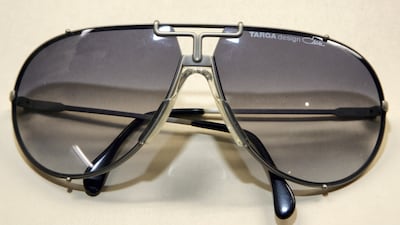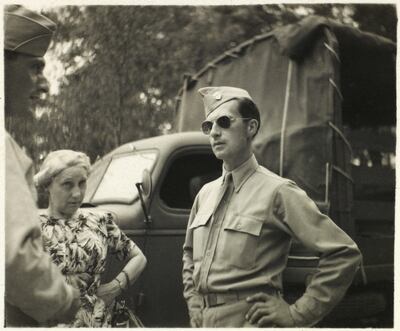As the name suggests, aviators were first produced for pilots – which is why they're also referred to as "pilot's glasses". And although today's versions often come with reflective, blue- green- and even pink-tinted lenses, early aviators were designed with function, rather than fashion, in mind. American company Bausch & Lomb, known for its contact lenses and eye-related medical products, created aviators in 1936, after it was asked to produce protective glasses for fighter pilots during the First World War, to block out the sun's glare. At the time, the company made binoculars and telescopes.
It wasn't until the Second World War, however, that the eyewear silhouette really became a fashion statement, emblematic of the handsome, reliable and fearless American hero. Updated styles featured gradient effects on the lenses, so that a coating on the upper halves would provide enhanced protection, and the lower, uncoated halves would allow for clear views of the plane's cockpit.
The aviators manufactured by Bausch & Lomb were ideal successors to basic pilots' goggles, which failed to mask the glare of the sun at high altitudes, making pilots feel light-headed and nauseated. These filtered out the dazzling brightness, and soon got their own trademark name – Ray-Bans, since they were literally banning the sun's rays.
By 1937, aviators were available to the public, and featured plastic frames. The following year, they were remodelled with metal frames, and marketed as Ray-Ban Aviators. Later variations of the silhouette targeted outdoorsmen, and were advertised as ideal eyewear for hunters, shooters, fishermen and golfers, before adapting to the female consumer.
In the 1950s, military fashion played a role in influencing mainstream fashion trends, and aviators emerged as a key micro-trend. The Ray-Ban Caravan style was launched in 1957, and was worn by Robert De Niro in the 1976 film Taxi Driver. In the 1970s and 1980s, however, aviators were overshadowed by the dramatic disco and retro shades that were in vogue at the time. On the brink of extinction, they were effectively revived by Tom Cruise.
In 1982, Ray-Ban signed a Dh183,660-a-year deal to have the sunglasses appear in over 60 movies and television shows. And in 1986, when Cruise donned aviators for his role in Top Gun, the design's cult status was cemented. After the film's release, Ray-Ban sales reportedly increased by 40 per cent.
Over the years, aviators have become almost emblematic of celebrities like Robert Redford, Michael Jackson and even Elvis Presley, whose signature eyewear included gold-rimmed aviator sunglasses with orange- or lavender-tinted shades.
In recent seasons, luxury fashion houses have redefined aviators by exaggerating the shapes of the lenses, adding colourful brow bars, scaling back the opacity of the tints and bedazzling the frames with embellishments.

But current designs are heavily influenced by retro elements, and both oversized frames and aviator styles have been combined to present one of the hottest eyewear trends of the season: aviator optical glasses. These vintage-inspired offerings feature minimalist, lightweight wire frames and large clear lenses. If you’re looking for a pair, Bottega Veneta’s sleek silver aviator glasses for men are absolutely exquisite.
_______________________
Read more:
Tracing the evolution of the humble bumbag
What makes these scuffy shoes worth Dh150,000?
Hollywood fashion: Bottega Veneta relaunches Lauren 1980 clutch
_______________________



